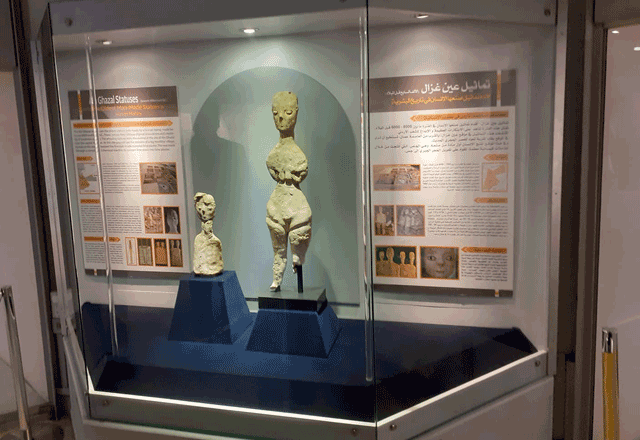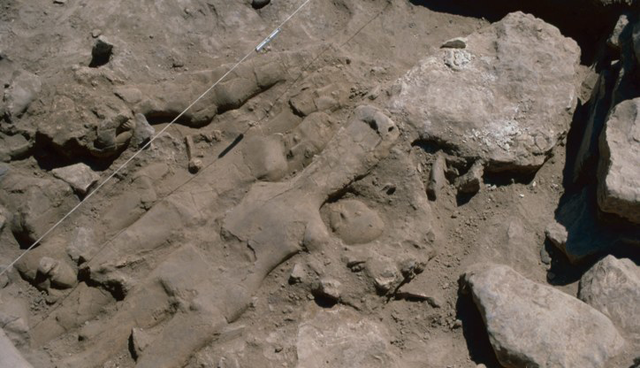You are here
Google Doodle celebrates Jordan’s Ain Ghazal statutes on their 40th discovery anniversary
By Saeb Rawashdeh - Oct 01,2023 - Last updated at Oct 01,2023

The statues from Ain Ghazal displayed at the Archaeological Museum in Amman (Photo by Saeb Rawashdeh)
AMMAN — Global search engine giant Google celebrated the 40th anniversary of the discovery of the 9,200-year-old Ain Ghazal statues, which are among the earliest large-scale representations of human form, on Saturday with a Google Doodle.
The discovery of the Ain Ghazal statues is one of the major archaeological discoveries uncovered in Jordan in recent decades, noted Professor Emeritus Zeidan Kafafi
“The fact that Google celebrates Ain Ghazal statues gave them importance, and statues are under the spotlight, which means that the discovery isn’t only a Jordanian cultural heritage but also a universal treasure,” Kafafi, who is also the former president of Yarmouk University in Irbid, told The Jordan Times.
Many media outlets in Jordan and around the world have covered the artifacts at the Neolithic site of Ain Ghazal, near Marka Shamalia in Amman, Kafafi said.
He added that interest in Ain Ghazal has existed since the 1980s when specialised archaeological and historical magazines wrote about the site.
“Statues from Ain Ghazal are displayed at several local and international museums: The Archaeological Museum on Amman Citadel, the Jordan Museum in Ras Al Ein, the Museum of Jordanian Heritage in Irbid, Louvre Museum in Paris and Louvre Museum in Abu Dhabi,” Kafafi said, adding that “the statues became ambassadors for Jordanian cultural heritage”.
Archaeological sites available to tourists in Amman are limited to the Amman Citadel, the Roman Theatre and the Jordan Museum, Kafafi said.
He stressed that not only should Ain Ghazal be included in the Amman Tourist Trail, but also significant sites from the Iron Age.
“In 1988, the Godfather of Ain Ghazal, Gary Rollefson, and I proposed to upgrade the site for tourist purposes,” Kafafi said. “Unfortunately, instead of promoting the site, we are losing much of Ain Ghazal due to urban development.”
That plan included erecting a wire fence around a certain portion of the site.
Although this step was completed, the rest of the project failed to materialise as other urgent financial and social problems had to be addressed, Professor Emeritus Gary Rollefson said.
Kafafi also stressed that conditions at museums where statues are displayed have to be regulated in order to keep sculptures intact. Due to a higher temperature there is a risk that glued pieces will deteriorate, Kafafi said.
“The Google page was a wonderful gesture and reflects the importance the world holds for the splendid publicity afforded to the cultural heritage of Jordan. It is also very heartening to realise the excellent international cooperation that permitted the preservation and conservation of the statues by the efforts of the University College London, the British Museum, the Smithsonian Institution, Royal Jordanian Airlines, the British Institute in Amman for Archaeology, American Centre of Research, and of course, the Department of Antiquities and the Ministry of Tourism and Antiquities,” Rollefson said.
The development of the Jordan Museum under the guidance of Princess Sumaya has also been a very effective tourist attraction in Jordan and Amman, Rollefson added.
Rollefson said that despite past struggles there is still a lot of potential for Ain Ghazal as a tourist attraction, but it would be a major financial commitment to make that happen.
“First, the North Field, which has two unique shrines from c. 7,200 BC, has to be completely cleaned and preserved ... both shrines are almost destroyed by erosion and neglect,” Rollefson said.
During the COVID years, as the development of the Bus Rapid Transit continued swiftly, “an apparent lack of consideration in planning meant that part of the Ain Ghazal archaeological site was removed for a bus lane”, Rollefson said.
“The paucity of local interest and administrative lack of communication must be cured in the near future, with dedicated efforts to obtain financial support, both international and Jordanian,” Rollefson said, underscoring, “without this commitment, I think the site will not play an important role in touristic development of Amman.”
Related Articles
AMMAN — The number of archaeological fieldwork projects in Jordan has increased in the last several decades, noted Professor Emeritus Zeidan
AMMAN — A Neolithic age statue from Jordan will be exhibited at a new branch of the Louvre Museum opening in Abu Dhabi in January, a governm
AMMAN — Last week, the National Library organised a launch of a new book by Professor Emeritus Zeidan Kafafi, a former president of Yarmouk














